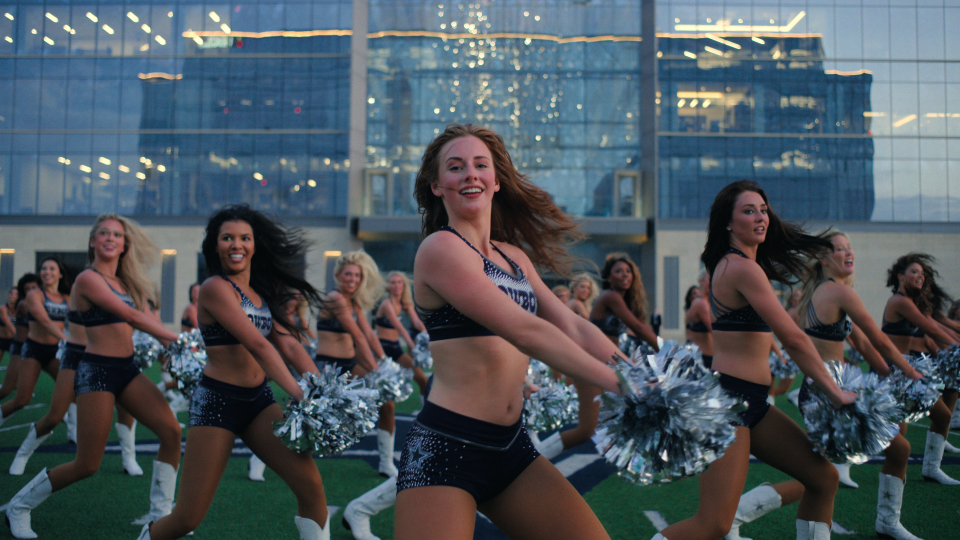The Dallas Cowboys Cheerleaders Go Through Hell. To Them, It’s Worth It
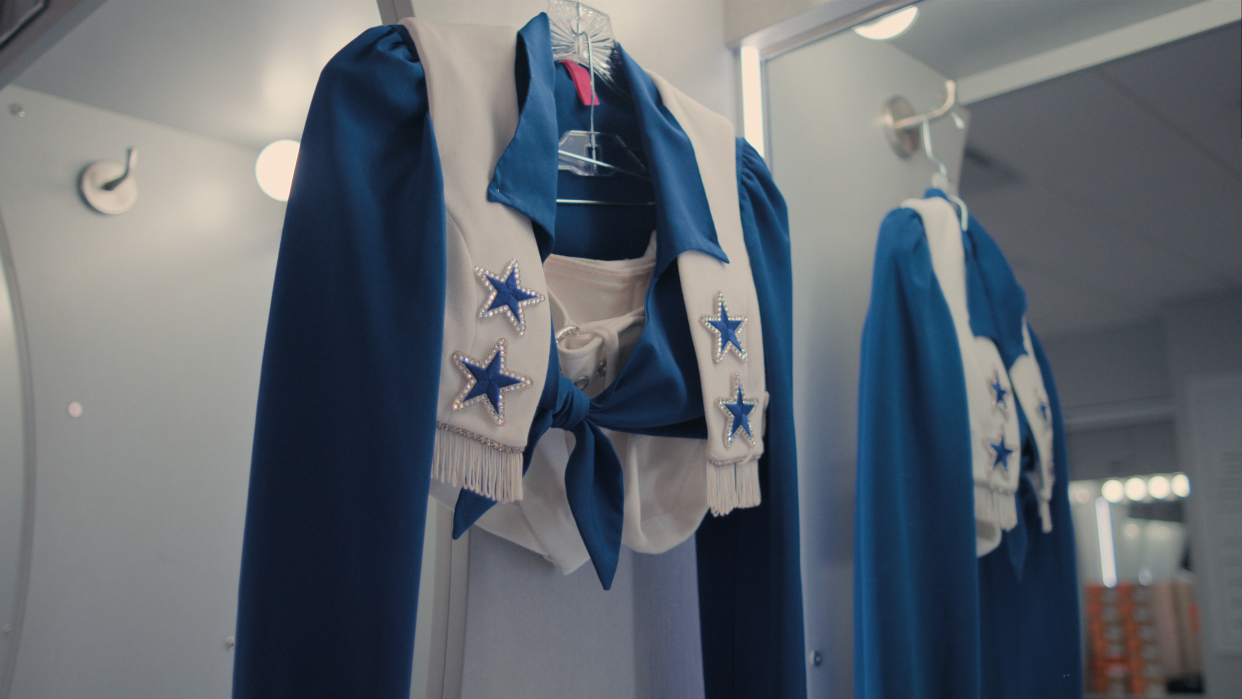
Courtesy of Netflix
Even if you’re not a football fan, it’s hard not to get hooked on America’s Sweethearts: Dallas Cowboys Cheerleaders. The latest Netflix docuseries, which premiered on June 20, follows the Cowboys’ cheer squad—known colloquially as the DCC—from tryouts to training camp, all the way through to the end of the football season.
The seven-episode series comes on the heels of CMT’s Dallas Cowboys Cheerleaders: Making the Team, a reality show starring many of the same characters, including DCC director Kelli Finglass, which ended in 2021 after 16 seasons. By comparison, America’s Sweethearts has a more professional sheen, which comes courtesy of director and executive producer Greg Whiteley, the man behind Netflix docuseries hits like Cheer and Last Chance U.
“There’s a certain prestige in [the Dallas Cowboys] community that comes from being in that orbit, but it also demands everything of you,” explains Whiteley of what drew him to the project. “I find all of that fascinating, and I thought it was an interesting world for us to explore; it was a great privilege to be given the access we were given to do it.”
Whereas CMT’s show was more surface-level, Whiteley and his team delve into all aspects of life as a member of one of the NFL’s most elite cheer squads. For many members of the team, and even aspiring members of them team, great sacrifices are required. Some women give up their lives—including jobs and relationships—to move to Texas to train; others grin and bear it as their bodies literally crumble under the strain of demanding dance moves, like the jump split (which is exactly what it sounds like).
Sports
The salary for an NFL cheerleader may surprise you.
All the while, most dancers hold down full-time jobs in order to make ends meet, arriving at practice after their 9 to 5s, where they’ll dance until well after midnight. But it’s not all high kicks and smiles. Finglass and her team, as well as Cowboys executive vice president and chief brand officer Charlotte Jones, often pick apart the girls’ looks, from their makeup to their weight, with sometimes devastating consequences.
It’s these moments that can be the most infuriating to viewers. “The world is moving in one direction, and here’s this institution that’s been largely the same since 1972 but is still wildly popular and wildly successful…. It’s an interesting dilemma,” says Whiteley. “I don’t know what you do about it.”
Read on for Glamour’s full conversation with America’s Sweethearts: Dallas Cowboys Cheerleaders director Greg Whiteley.
Glamour: What made you interested telling the story of the DCC? Was there something about the Dallas Cowboys franchise specifically?
Greg Whiteley: I wasn’t interested. The Cowboys initially approached, and I thought, Oh, we’ll never get the editorial control we need to do the type of filmmaking that we seek to do. So I told my agent, “Hey, politely, tell them thanks for their interest, but I just don’t see this working.” It was Charlotte Jones who came back and said, “We’re open to giving editorial control. We would want to meet with Greg first.” And I thought, Well, I’m never going to turn down a meeting with the Charlotte Jones of the Dallas Cowboys. So I flew out there, and I was so impressed, it forced me to take a harder look at this world.
It checked a lot of boxes for us. It’s an age group that is incredibly interesting; for the first time you’re starting to entertain some of those existential questions that are going to now plague you the rest of your life. I also think it’s this strange world of glamour, but also there’s a working-class nature to it. They don’t make a ton of money, so they have to have jobs outside of being a Dallas Cowboys cheerleader.
The physical demands of being a cheerleader are such that their lives can be pretty intense. I thought that would be interesting. The world of the Dallas Cowboys is a lot like what I would imagine living near Windsor Castle in the 1800s would feel like. When you’re a part of that inner circle of the Dallas Cowboys, it must feel like you’ve been invited to court. There’s a certain prestige in that community that comes from being in that orbit, but it also demands everything of you.
As Kelli Finglass will tell you, “Do nothing to tarnish the star.” You can feel that from the people who have actually been paid to physically polish the star, up to Jerry Jones, the team owner. I’m sure they all feel this need to uphold this brand. I find all of that fascinating, and I thought it was an interesting world for us to explore. It was a great privilege to be given the access we were given to do it.
The access was incredible. That was actually one of my questions, about how much control you had over what you covered. If Charlotte approached you, I imagine there was little that was off-limits.
They’re very proud of what they have in the Dallas Cowboys Cheerleaders, and they’re anxious for it to be authentically on display. I was impressed with…given all that they have invested in that brand, that they were willing to allow us (a) the access and (b) the editorial control to tell the story as we saw fit.
There were some very vulnerable moments on camera, from Victoria opening up about her eating disorder to a dancer being assaulted while on the field. How do you go about filming such sensitive moments or choosing what to share?
My job is the same whether we’re covering a competitive college cheer team in Texas or a junior college football team in Mississippi or the Dallas Cowboys Cheerleaders. We’re to show up, be curious, be open, and follow the story where it leads us. We’re going to film these girls as authentically as we can and then shape it, hopefully, into a story that becomes something that is accessible to as big an audience as we can make it. Invariably, if you’re committed to those principles of filming what’s really true, you’re going to bump up against some uncomfortable topics, and the Dallas Cowboys deserve infinite credit for not shying away from any of those topics.
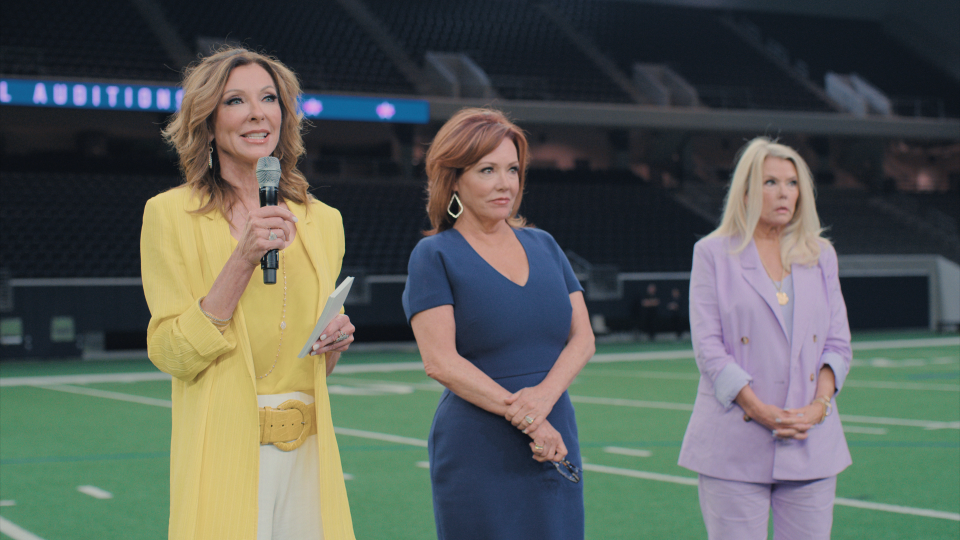
I came into the show not really knowing a lot about the DCC world, or even football, so I was kind of shocked at the intensity of some of it. I have to say—and I think that some Glamour readers might feel the same way—I found that some of it felt a little regressive in terms of the standards that these women are held to. Did you get the sense from the dancers that they were either bristling at [some of the beauty standards], or that maybe they were uncomfortable with them?
Our impression was that by the time you have made it to the finals of auditioning to become a Dallas Cowboys cheerleader, you sort of know the price of poker. You’re not surprised at all by the uniform, by the routines, by what is expected of you. Many of them knew Dallas Cowboys cheerleaders that were friends. Some of them, even their moms were Dallas Cowboys cheerleaders, so they grew up knowing the world. Nobody seemed to be surprised. What I think was interesting, and I continue to find interesting, is here is a thing including a uniform that was invented in 1972 and has remained largely unchanged. It’s really only become refined, but it’s the same. The uniform is the same. What they’re seeking to do in terms of on-field entertainment is largely the same, but the world has radically changed.
What do you do when you have this institution that is globally beloved and popular? I will tell you, that power they wield is real. There are people that show up to Dallas Cowboys football games only to see the Dallas Cowboys Cheerleaders. When you watch the cheerleaders show up to an old folks’ home or to a hospital, the types of joy, the authentic joy that you can see in people’s eyes when they are meeting a Dallas Cowboys cheerleader for the first time in person, it’s really heartwarming and interesting. So, how do you change it? The world is moving in one direction, and here’s this institution that’s been largely the same since 1972 but is still wildly popular and wildly successful…it’s an interesting dilemma, and I don’t know what you do about it.
One of the biggest questions that I think people will have is about the DCC salary, and the fact that most dancers have full-time jobs in addition to dancing. Is there anything you can share about the salary? It seems very unclear. Do you have any info about their pay structure? If they’re paid by the hour or by game?
I never got a clean answer—“specifically, this is how much they make”—and I think that’s because it varies depending on how senior you are in the group. You may even get paid more if you’re a group leader, though that was never clear to me.
I’ve learned that dancers the world over are underpaid. Actually, the Dallas Cowboys are on the higher end of that pay scale, if you were totaling it on a per-hour basis. But whether you’re a professional dancer in New York or LA, or if you happen to dance for the Dallas Cowboys Cheerleaders, you are not making as much as the world probably thinks you are making, or maybe what you ought to be making. There are so many people who want to do it that it makes it hard to negotiate.
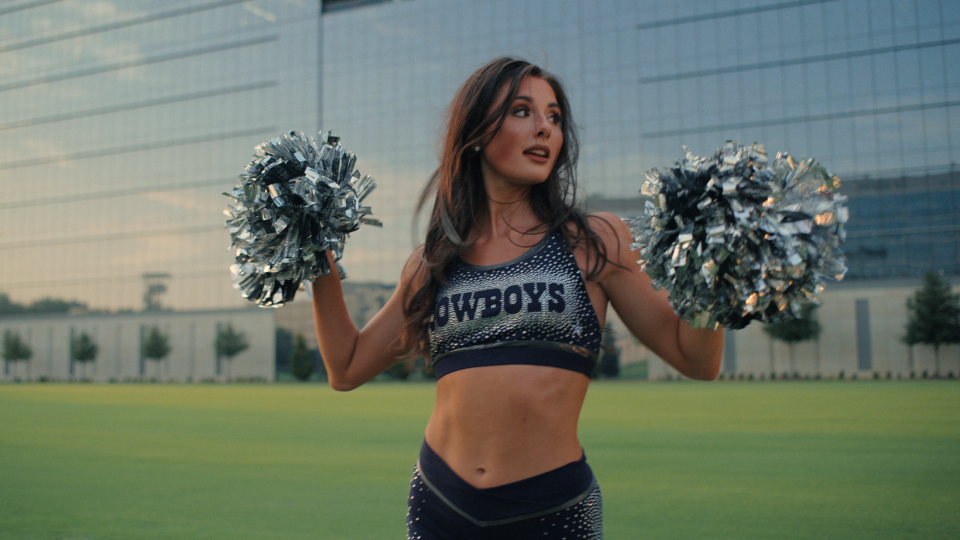
I was trying to Google whether or not there was an NFL cheerleader’s union or something. There’s so little information out there, and what is out there is inconsistent.
As far as NFL cheerleaders go, I can say this with a high degree of confidence: that the Dallas Cowboys Cheerleaders are on the highest end of that pay scale. I’ve heard horror stories of what a typical NFL cheerleader makes, but the Dallas Cowboys Cheerleaders fall into a new category. None of them are rich. None of them are getting paid a ton, but it isn’t the same dearth of payment that I think other NFL cheerleaders have to experience.
You spent so much time with the DCC. Would you classify their job as part-time in terms of the hours they’re putting in? Between practicing and taking care of their bodies?
I find it to be a full-time job. The job is all-consuming. The fact that they could hold down, many of them, full-time jobs in addition to dancing was astounding to me. We filmed—and in a couple of cases, in-depth—the schedule that they have to maintain in order to do both things. A full-time job somewhere else, and then cheer for the Dallas Cowboys Cheerleaders, is tough. But there’s no shortage of volunteers waiting to sign up to do it.
I was really rooting for Anisha; she was so impressive. Can you tell me a little bit about why you chose to highlight her story out of the rookies?
I think the same reason, Sam, that you liked her. We liked her too. She’s cool, she’s of Indian descent, so to a degree she’s going to stick out a little bit. Her solo routine was a Bollywood-inspired dance routine, which was really fun. And then the fact that she’s an orthodontist was great and she was willing to let us film her at work. We loved her. She was great.
I wanted to touch on one of Anisha’s comments that stuck with me when another of the auditioning dancers was cut. She was like, “We’ve got to do it for the Brown girls.” Do you feel like [women of color] had a harder time achieving some of the standards that the DCC were held to?
The history of diversity, people of color, and the Dallas Cowboys Cheerleaders is actually a fairly encouraging one. There was a woman named Dee Brock, who is the originator of the Dallas Cowboys Cheerleaders, and it was very important to her that there were Black and Brown people represented in the squad. So you have girls in the late ’60s, you have Black members of the Dallas Cowboys Cheerleaders, where I think you’d be hard-pressed to find cheerleaders period on the sidelines at that stage.
It’s always something that needs to be addressed and thought about…. What Dee Brock would always say is, “If you’re going to be America’s team, you have to represent America.” And America has Black and Brown people. The Cowboys have always made it a point to try and do that, but you raise a good point. The first two people cut after the finals in training camp are people of color, and that was not lost on them.
You mentioned earlier that some of the women are entering this next phase of life and tackling big, existential questions for the first time. Is there anything specifically about being part of the DCC that makes it harder for them to transition back to regular life?
For many of them, the goal of becoming a Dallas Cowboys cheerleader requires so much so early in your life that you almost have to engineer your life toward that one goal. It is pretty all consuming. So if you’re fortunate enough to become a Dallas Cowboys cheerleader, you’re only going to be one for three, four, if you’re lucky, five years. And what do you do when you’re done with that? Many of them will tell you, and we spoke to a lot of alumni, there are things you learn in the process of going through that juggernaut of an experience.
That gauntlet sort of prepares you for all kinds of things later in life. But the one thing that is almost impossible to prepare for is, What do you do when you’re 25 and you’ve already achieved your dream? That’s the hardest thing to wrestle with, at that stage: Do you have a second trick, a second goal? A lot of them found life after the DCC to be less exciting. Of course, it is this very singular, unique experience that is not unlike what I think a professional athlete experiences. How do you duplicate it later in your life?
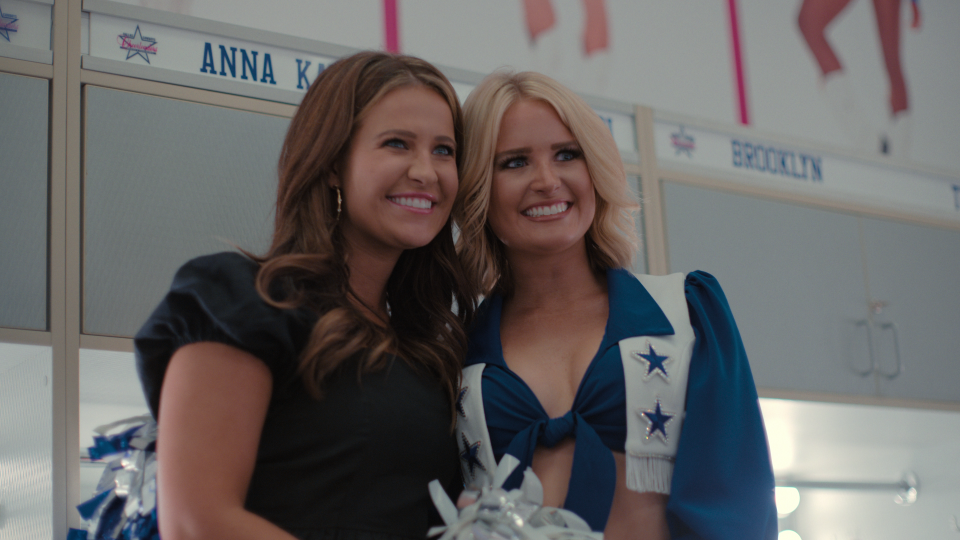
Especially knowing that they don’t have a lot of money, or maybe individual fame that they can then monetize that into something further the way an athlete might…I’m thinking of Caroline, who had to have hip surgery after retiring and at the same time watch her younger sister join DCC. Were there any other legacies that stood out to you?
Well, you had Madeline’s mom. She actually met her husband, who was a camera operator for the Dallas Cowboys, through DCC. And then there are all those alumni that come back. We interviewed dozens of them.
The recurring theme is just that the older they get, the more they’re able to look back with extreme fondness over that period of time in their life. And there is this: They use this phrase sisterhood. There is a sorority that exists among all of the Dallas Cowboys cheerleaders.
I think there are only 800 of them on planet Earth, somewhere around that number. But when they meet and they get together, there is a bond that, to me, sort of reminds me of people that have served in the military; they’ve been through some very unique, singular intense experience. They’ve bonded. They will be bonded for the rest of their lives. They could not say two words to each other for 15 years, but the moment they see each other, they have tons to talk about and relate and bond over. I found that aspect of it to be interesting.
Were you a fan of the original CMT series, Dallas Cowboys Cheerleaders: Making the Team?
I’d never seen the show, and I still haven’t ever seen the show.
Really? Do you plan to?
No, I don’t plan to. There are certain elements of the show that we’ve borrowed from because different girls that we were following referenced specific moments of being on the show, so it became salient to telling their story. But for whatever weird reason, I have never seen it. I’m not opposed to it. I don’t even know how I would watch it now.
Did your work on Cheer influence at all the way you wanted to cover the DCC? They’re obviously very different, but were there any unusual similarities?
I don’t think that there are any similarities that I couldn’t also apply from my days of filming Last Chance U. There’s a group of people involved in a very intense activity that they love. They each want something, and we’re doing the best we can to film whether or not they get it.
The only thing that the show Cheer and America’s Sweethearts have in common is that technically they’re both cheerleaders. They both belong to the world of cheerleading, but that world is so vast. The Dallas Cowboys Cheerleaders... It'd be way more accurate to describe them as a dance team than a competitive cheer team.
What is the plan for next season? Is there going to be another season?
Personally speaking, just as a filmmaker, I think there’s plenty of story to be told. There’s enough turnover at the DCC; and with our style of filmmaking, we only get to a small handful of them. Even with the existing members of the team that we didn’t film, those that choose to return, there’s plenty of story to be told. I’m curious to see how this show does, and then we probably address that question then.
I really want to know what happens with Victoria, though I guess they’re probably coming up on tryouts for the following season already.
Yes, they’re in the middle of figuring that out now.
Was there anything else you wanted to share about the process, about the girls, about your own experience? Are you a former dancer or cheer person?
I’m not. I’m not. Much to my shame. I wish I had that skill, that talent. I do not.
Had to ask!
Originally Appeared on Glamour

